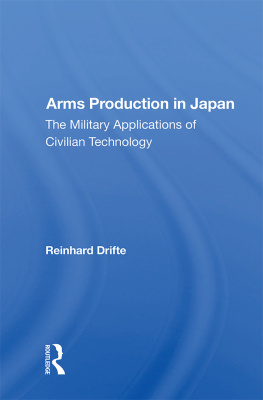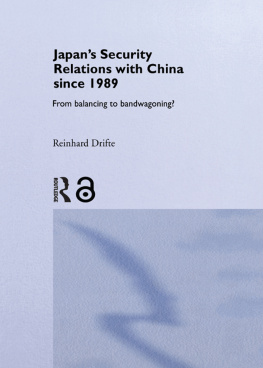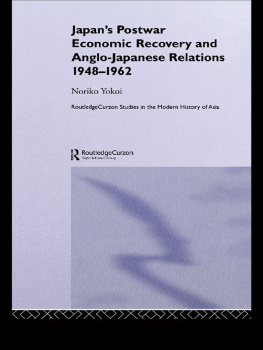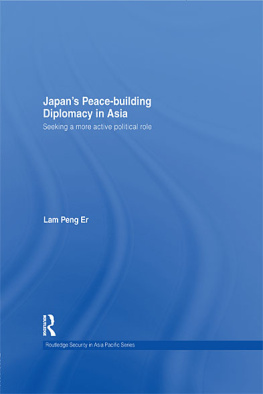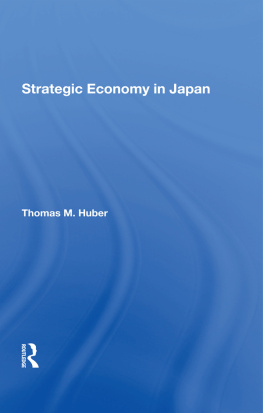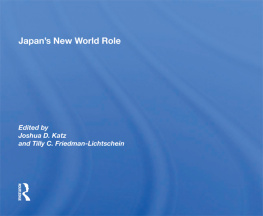Arms Production in Japan
About the Book and Author
Although Japan's arms industry is still relatively small, significant political, economic, and technological developments indicate its growing importance and pave the way for Japan's increasing involvement in arms production. In this comprehensive study, Dr. Drifte examines both the domestic and international environments that are encouraging Japan's leaders not only to strengthen the country's defense, but to do so more independently. Until recently, the arms industry had been nurtured by U.S. weapons technology, but the growing dependence on electronics in modern weapons systems will shift the emphasis to Japan's technological sophistication.
The electronics revolution is creating more and more dualpurpose products that undermine the Japanese cabinet policy prohibiting arms export. Currently, the incentive to master new technologies through arms-related R&D is the greatest lure for Japan's entry into arms production. Unlike those in many other countries, Japanese manufacturers can easily transfer civilian technologies to military uses; thus the discovery of a wider application, beyond the whims of recession, for their most advanced civilian technology is yet another motivation leading Japan into this arena. Dr. Drifte illustrates that the country's way of handling arms-related production and technology is a valuable and dynamic example of the success of Japan's industry as it enters new technological areas.
Reinhard Drifte is assistant director for regional security studies, International Institute for Strategic Studies, London.
Arms Production in Japan
The Military Applications of Civilian Technology
Reinhard Drifte
First published 1986 by Westview Press, Inc.
Published 2018 by Routledge
52 Vanderbilt Avenue, New York, NY 10017
2 Park Square, Milton Park, Abingdon, Oxon OX14 4RN
Routledge is an imprint of the Taylor & Francis Group, an informa business
Copyright 1986 Taylor & Francis
All rights reserved. No part of this book may be reprinted or reproduced or utilised in any form or by any electronic, mechanical, or other means, now known or hereafter invented, including photocopying and recording, or in any information storage or retrieval system, without permission in writing from the publishers.
Notice:
Product or corporate names may be trademarks or registered trademarks, and are used only for identification and explanation without intent to infringe.
Library of Congress Cataloging-in-Publication Data
Drifte, Reinhard.
Arms production in Japan.
(Westview special studies on East Asia)
Includes index.
1. MunitionsJapan. I. Title. II. Series.
UF535.J3D74 1986 338.47355820952 86-15765
ISBN 13: 978-0-367-01077-5 (hbk)
To my mother
This book is based on an earlier and shorter monograph published in the series of Occasional Papers of the Programme for Strategic and International Security Studies at the Graduate Institute of International Studies in Geneva, where the author was research fellow from 1980 to 1984.
The author wishes to thank Gavin McGuire for having corrected the English manuscript and Heino Kopietz and Andres Fineueret for having helped with the tables.
The views expressed in this book are the author's own and should not be taken to represent the views of the International Institute for Strategic Studies, at which he is currently assistant director.
Reinhard Drifte
London
Japan is the world's second strongest economic power. It exports the most sophisticated products worldwide, although its imports consist mainly of fuel and raw materials. Japan achieved this status within a relatively short time thanks to among other factorshighly efficient and cost effective production technologies and organisation as well as smooth relations between labor and management on the one side, and industry and government on the other.
It is usually taken for granted that an economic power of this size should have a commensurate military establishment, which in turn should be supported by an equally proportioned arms industry. In fact, Japan has only 243,000 troops, and huge industrial groupings in all manufacturing sectors notwithstanding, arms-related production occupies only a small fraction of the country's economic activity, in absolute as well as relative terms. The reason for this lies in Japan's postwar pacifism, which gave birth to a ban on arms exports. This ban allows arms production only for the supply of the Japanese armed forces. Hence, annual sales in arms related production are relatively weak, amounting in fiscal year (FY) 1983 to 1.11 trillion yen ($4.68 billion; $1 = 237 yen). For this reason, Japan's arms production (which occurs under the guise of relatively small subunits in huge manufacturing companies), has so far received only scant attention outside of the country.
In the Japanese specialist literature arms production is discussed almost exclusively by liberal and leftist writers. These authors mostly approach the subject by warning of a revival of the Japanese arms industry complex.
Developments on the political, economic and technological level, however, warrant closer attention to Japan's activities in this sector because they have a marked impact on foreign interests. On the political level, for instance, the Japanese Government has made an exception to the ban on arms exports and allowed the export of Japanese arms-related technology to the United States. This move has to be considered against the background of rising industrial pressure to do away with the export ban altogether. The increasing use of electronic parts in modern weapons tends to render the arms export ban ineffective. There also is a tendency among Japanese companies to establish arms-related production and research units as a means of production diversification, as a cushion against recession and as a generator of investment and technology.
The purpose of this short overview of Japan's arms production capability is to contribute to a better understanding of Japan's economic success by highlighting a special segment of Japan's industry that plays a major role in its future direction. Instead of merely limiting the investigation of this success to areas of Japanese management, it is also time that the relationship between civilian and arms-related production/technology be investigated in order to discover how Japan's industry measures up to analogous industrial sectors, such as aeronautics, in Europe and in the United States.
The first step in this investigation is to distinguish between Japan's arms-related production and an arms industry. As will be shown, the Japanese arms producer lacks the following characteristics generally associated with an arms industry:
- an overwhelming reliance on the production of arms or arms-related products;
- an important government-supported R&D program as the prime impetus for involvement in arms production;
- export of arms.
Japan's politicostrategic environment has been changing rapidly in recent years because of a worsening of the strategic environment in East Asia as evidenced by the following events:
- the U.S. defeat in Vietnam in 1975;
- the ongoing discussion from 1977 to 1979 of a possible withdrawal of U.S. ground troops from South Korea;

